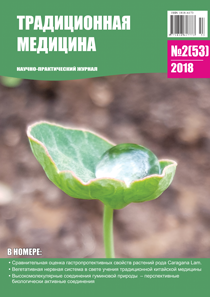Autonomous nervous system in the light of traditional chinese medicine
Keywords:
traditional chinese medicine, autonomic nervous system, vegetotome, skin segment of autonomic support, skin-synaptic pointAbstract
Based on the theory of Traditional Chinese Medicine (TCM), the author analyzed the main provisions of TCM with known and new data on the neurophysiology of the autonomic nervous system. In addition, one of the conclusions of the article is the statement that the theory of traditional Chinese medicine illuminates, albeit by a metaphysical language, but all the basic regulatory mechanisms – neural, humoral, electromagnetic. Meridians are conditional lines of the main directions of propagation of electromagnetic field gradients along the body, and the meridian system is a system for maintaining electromagnetic homeostasis, which is an integral part of the overall homeostasis of the organism. In this case, the electromagnetic fields that propagate along the meridians, and, in fact, along the nerve conductors, constitute the concept of «energy of the meridians». A skin-synaptic point is a skin area (biologically active point) and subcutaneous layers (acupuncture point) with special electrical and physiological properties that differ from the surrounding skin. Skin-synaptic points located within the skin segments of autonomic support, in fact, perform electromagnetic separation of the external field.
References
Вогралик В.Г., Вогралик М.В. Пунктурная рефлексотерапия. – Горький: Волго-Вят.кн.изд-во, 1988. – 336 с.
Бойцов И.В. Диагностика по «риодораку»: тес-тирование кожных симпатических рефлексов. – Н.Новгород: Поволжье, 2013. – 246 с.
Бойцов И.В. Электропунктурная диагностика по «риодораку». – Витебск, 1996. – 192 с.
Вегетативные расстройства: Клиника, диагностика, лечение / Под ред. А.М. Вейн. – М.: Мед. информ. Агентство, 2003. – 752 с.
Лычкова А.Э. Механизмы синергизма отделов вегетативной нервной системы: дис. … докт. мед. наук. – М.: 2003. – 319 с.
Бойцов И.В. Динамическая сегментарная диагностика. Руководство для врачей. – Н.Новгород: Поволжье, 2014. – 460 с.
Бойцов И.В., Белоусова Т.Е. Взаимосвязь электродермальной активности и патологии внутренних органов // Физиология человека. – 2015. – Т. 41. – № 6. – С. 104-113.
Бойцов И.В. Способ тестирования кожных симпатических реакций и концепция вегетотома // Медицинский журнал. – Минск, 2011. – №2 (36). – С. 23–27.
Гурьянова Е.А., Любовцева Л.А., Шабукова А.А. Исследование функционального состояния тучных клеток кожи в области точек акупунктуры после игло-укалывания // Нижегородский медицинский журнал, 2008. – № 5. – С. 110–114.
Кашутин С.Л., Добродеева Л.К. Содержание иммунокомпетентных клеток в коже у практически здоровых людей // Мед. иммунология, 2000. – № 2. – С. 128–129.
Портнов Ф.Г. Электропунктурная рефлексотерапия. – Рига: Зинатне, 1988. – 352 с.
Бойцов И.В. Использование гальванического тока для исследования электродермальной активности // Физиотерапевт. – 2013. – № 1. – С. 70–78.
Guyton A.C., Hall J.E. Textbook of Medical Physiology. – W.B. Saunders Company Philadelphia, Pennsylvania, 2000. – 1104 p.
Подшибякин А.К. Об изменении электрических потенциалов во внутренних органах и связанных с ними активных точках // Физиологический журнал СССР, 1955. – № 3. – С. 35–36.
Downloads
Published
How to Cite
Issue
Section
License
Reproduction of any materials without the written permission of the publisher is prohibited.
The responsibility for the accuracy of the information contained in articles and advertisements are the authors and advertisers.


